Lost Museums of New York
Earlier this year, the metal façade of the American Folk Art Museum was dismantled and taken into storage as the Museum of Modern Art absorbs the institution’s former home. The loss of the fortress-like architecture on West 53rd Street is just the latest in the merging and destruction of New York City’s museums. These vanished museums — either closed completely or now invisible inside another, larger museum — all contributed to the cultural landscape of the city today, even if their names are mostly forgotten. Below are ten of these lost museums.
SCUDDER’S AMERICAN MUSEUM
Broadway and Ann Street, Manhattan
 Scudder’s American Museum, in the former NYC poor house (via NYPL)
Scudder’s American Museum, in the former NYC poor house (via NYPL)
One of the first museums to draw the crowds in Manhattan was Scudder’s American Museum, which ran from 1810 to 1841. First lodged in the city’s former almshouse, it was started by John Scudder with the acquisition of some smaller museum collections, including the Baker’s American Museum. Eventually it relocated to a five-story building at Broadway and Ann Street, where patrons could pay a small price to see an 18-foot live snake, taxidermy dioramas, a two-headed lamb, magic lantern slides, bed sheets from Mary, Queen of Scots, and some macabre curios like a wax figure cut by a guillotine. It was even open until 9 pm, to wander by candlelight.
As P. T. Barnum wrote in 1869: “People in all parts of the country had sent in relics and rare curiosities; sea captains, for years, had brought and deposited strange things from foreign lands; and besides all these gifts, I have no doubt that the previous proprietor had actually expended, as was stated, $50,000 in making the collection.” In fact, Barnum was so impressed with the museum, he decided to buy it and transform it into the greatest spectacle the city had known.
BARNUM’S AMERICAN MUSEUM
Broadway and Ann Street, Manhattan
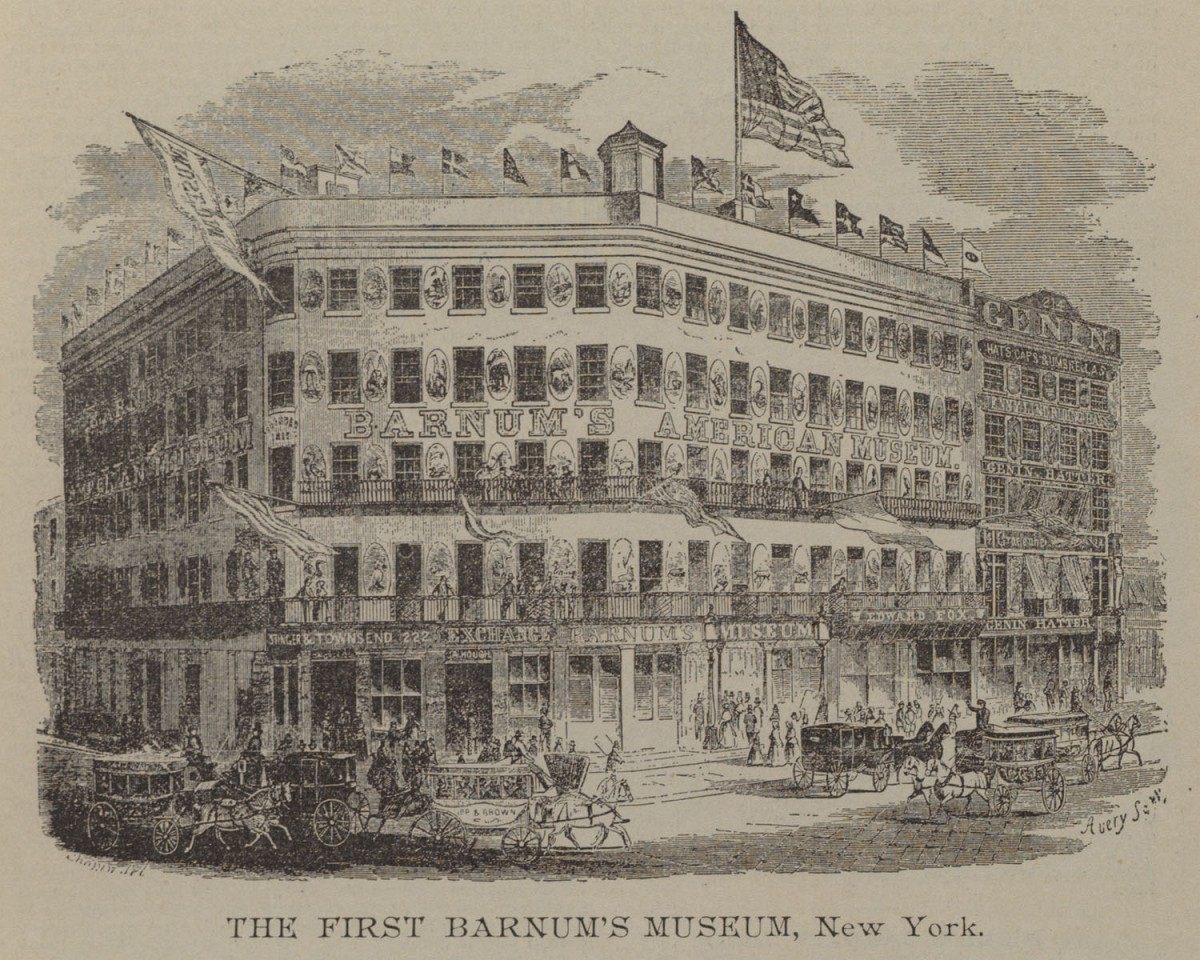 Barnum’s American Museum in New York (19th century illustration) (via columbia.edu)
Barnum’s American Museum in New York (19th century illustration) (via columbia.edu)
When Barnum bought Scudder’s American Museum in 1841, he turned the building at Broadway and Ann Street into a billboard blaring a jubilee of entertainment, from sideshow fakes like the Feejee Mermaid (really a monkey and fish sewn together) to living wonders like the Siamese twins Chang and Eng. A gargantuan Lecture Room hosted theatrical and educational events, and real animals as exotic as beluga whales delighted massive crowds.
Imitators sprung up all over the Bowery with dime museums, but Barnum was uncontested, at least until a devastating fire in 1865 that burned the whole place to the ground. Some reportedly cheered at the destruction of the sometimes banal and grotesque museum, but most were horrified at the loss of the city’s major cultural destination. Barnum tried again with another location, but that, too, burned down in 1868, so instead he went on the road with the circus that still has his name.
PEALE’S MUSEUM
252 Broadway, Manhattan
 Peale’s Museum (1825 watercolor) (via Museum of the City of New York)
Peale’s Museum (1825 watercolor) (via Museum of the City of New York)
A rival of Barnum was Rubens Peale, son of naturalist and Baltimore and Philadelphia museum creator Charles Wilson Peale. Peale set up his own New York museum in 1825, like Barnum offering a mix of natural and sensational wonders on Broadway, although a little more refined. As the Bowery Boys explain in their thorough post on the museum, Rubens “was sensitive to some of the cheap ploys of [his father’s] Philadelphia Museum (live animals, displays of human deformities) and tried to keep his New York museum a dignified affair, although today we would find its use of waxworks and flashy lectures rather silly.”
Eventually he rechristened the Peale’s Museum as the New York Museum of Natural History and Science, but séances and mesmerism were still known to take place within the walls. Unfortunately, Peale’s wunderkammer was wrecked by the Panic of 1837, and the impossible competition from Barnum.
PALEOZOIC MUSEUM
Central Park, Manhattan
 Sketch for the proposed Paleozoic Museum (1870s) (via Wikimedia)
Sketch for the proposed Paleozoic Museum (1870s) (via Wikimedia)
Benjamin Waterhouse Hawkins caused a sensation in England with his concrete dinosaurs at the Crystal Palace in 1851, so in 1868 the Central Park commissioners asked that he make an American version. This Paleozoic Museum was planned as a looming iron and glass building at Central Park West and 63rd Street, where concrete extinct animals would mingle beneath skylights.
Frederick Law Olmsted, one of the Central Park designers, set out the foundations, but Hawkins made a crucially bad enemy by speaking out against the corrupt Boss Tweed. Tammany Hall in turn sent its thugs to the Hawkins workshop in 1871, and smashed everything to bits. The shattered dinosaurs are believed buried beneath Central Park.
NAVAL LYCEUM
Brooklyn Navy Yard
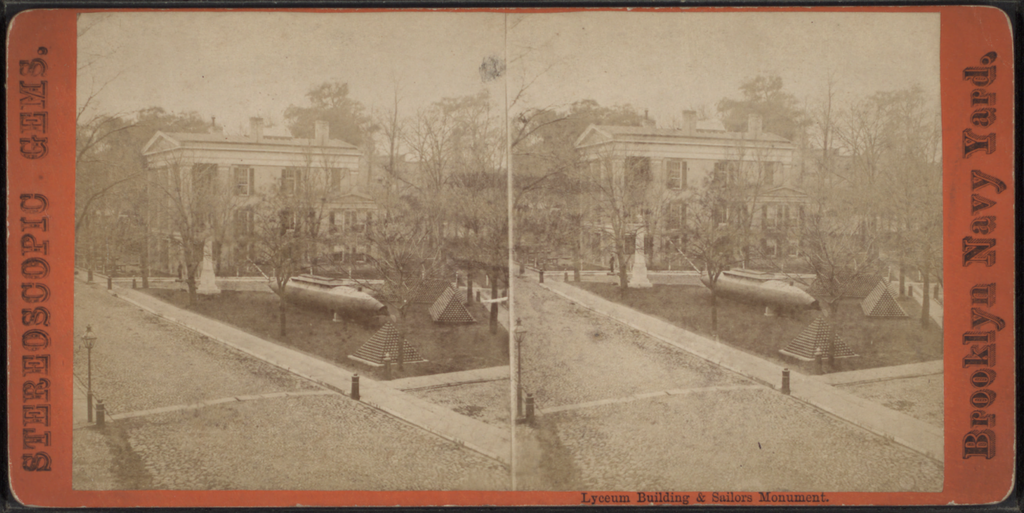 19th-century stereoscopic photograph of the Lyceum building at the Brooklyn Navy Yard (via NYPL)
19th-century stereoscopic photograph of the Lyceum building at the Brooklyn Navy Yard (via NYPL)
Not to be left out, Brooklyn had its own 19th-century curiosity cabinet at the Navy Yard. Established in 1833, the Naval Lyceum was a mix of nautical history and materials like model ships and publications, with wonders amassed by sailors around the world. As one visitor described in 1839: “Handsome cabinets of shells and minerals, elegantly arranged; many rare birds, in a perfect state of preservation, with a large and valuable collection of natural and artificial curiosities from every quarter of the globe, are among the first objects, on entering, which salute the eye.”
Waning support brought the museum to a close in 1889, and its objects were given to the Naval Academy in Annapolis.
AMERICAN MUSEUM OF PUBLIC RECREATION
Coney Island, Brooklyn
 Carousel animals in the American Museum of Public Recreation (via Brooklyn Public Library, Brooklyn Collection)
Carousel animals in the American Museum of Public Recreation (via Brooklyn Public Library, Brooklyn Collection)
Down in Coney Island in 1929, rides inventor W. F. Mangels — responsible for such innovations as leaping carousel horses — decided the American amusement park needed its own museum. The American Museum of Public Recreation honored, as he told the New York Times, “human reaction to play as expressed through play facilities man has created and developed.”
The museum with its carousel animals, ride models, and entertainment engineering displays didn’t last long, however, and Mangels sold his collection in 1955. But some of it still survives in the city, and a tollhouse sign once used by tourist carriages that was part of this collection is going on display at the Coney Island History Project in 2015.
MUSEUM OF FAMOUS PEOPLE
133 West 50th Street, Manhattan
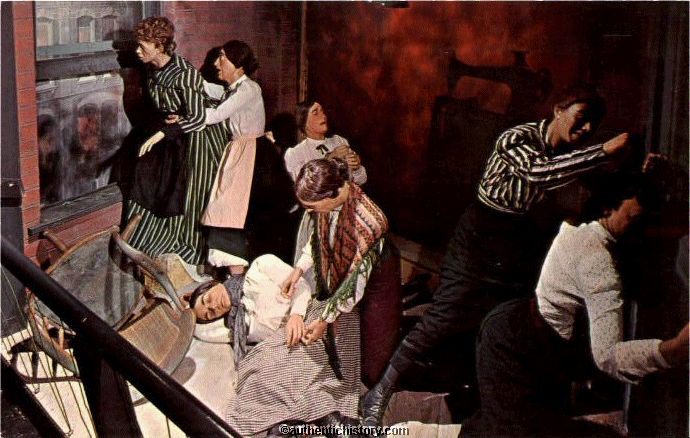 Triangle Shirtwaist Fire diorama at the Museum of Famous People (via authentichistory.com)
Triangle Shirtwaist Fire diorama at the Museum of Famous People (via authentichistory.com)
Before there was a Madame Tussauds in New York, there was the Museum of Famous People on West 50th Street. With around 50 dioramas of vinyl mannequins (a ”dramatic advance over traditional wax museums,” they claimed), the museum highlighted often harrowing New York history alongside global celebrities. This included the Triangle Shirtwaist Fire, the buying of Manhattan from the American Indians, Peter Stuyvesant with his peg leg, villains from Tammany Hall, and Houdini escaping from a trunk underwater.
Among the manic displays housed in underground passages was one of the Aaron Burr vs. Alexander Hamilton duel, which, as Fred W. McDarrah’s 1967 Museums in New York describes, was ”complete with birds chirping overhead and crickets down below.” The museum closed in the 1970s, the fates of its plastic figures unclear.
MUSEUM OF PRIMITIVE ART
15 West 54th Street, Manhattan
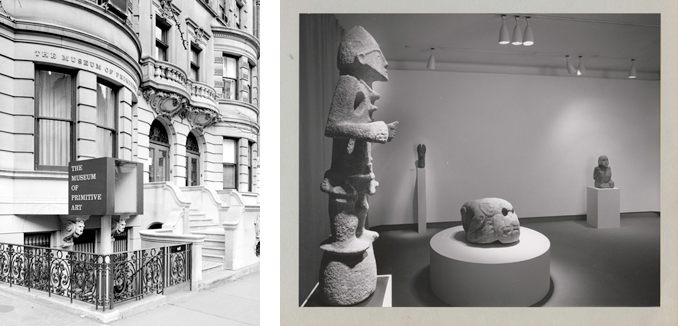 The Museum of Primitive Art (via Metropolitan Museum of Art)
The Museum of Primitive Art (via Metropolitan Museum of Art)
Some of the collections currently inside New York’s major institutions were once their own organizations, including the Museum of Primitive Art on West 54th Street. The rather insensitively named and organized museum focused on the art of “primitive” societies, which was a convenient and dismissive way to at once group indigenous art from the Americas, Oceania, and Africa, both ancient and contemporary.
The museum was opened in an Upper West Side townhouse in 1957 by Nelson A. Rockefeller, but closed in 1976, and its collections went to the Metropolitan Museum of Art.
SPORTS MUSEUM OF AMERICA
26 Broadway, Manhattan
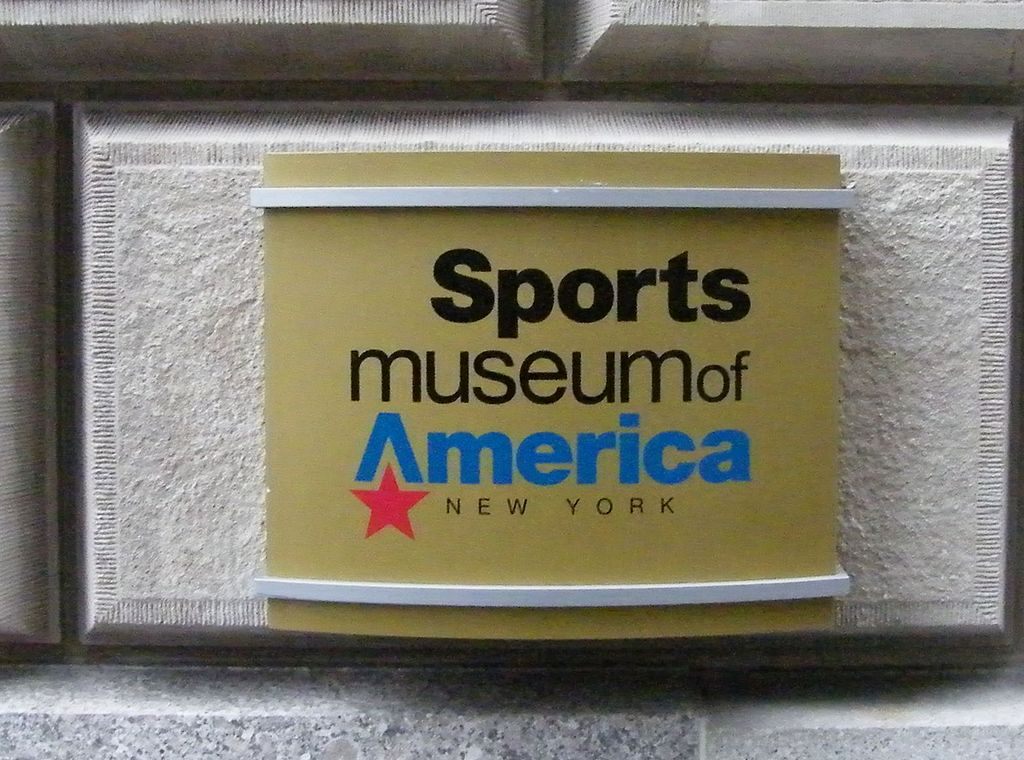
Sports Museum logo (photograph by Americasroof/Wikimedia)
A recent brief flame was the Sports Museum of America, which shut down after just nine months in 2009. It had high hopes to be the country’s first museum exploring both the history and culture of every type of sport, and started strong hosting prestigious events like the Heisman Trophy presentation.
However, the recession and the inability to bring in the expected million visitors a year cut the dream short.
THE GALLERY OF MODERN ART
2 Columbus Circle, Manhattan
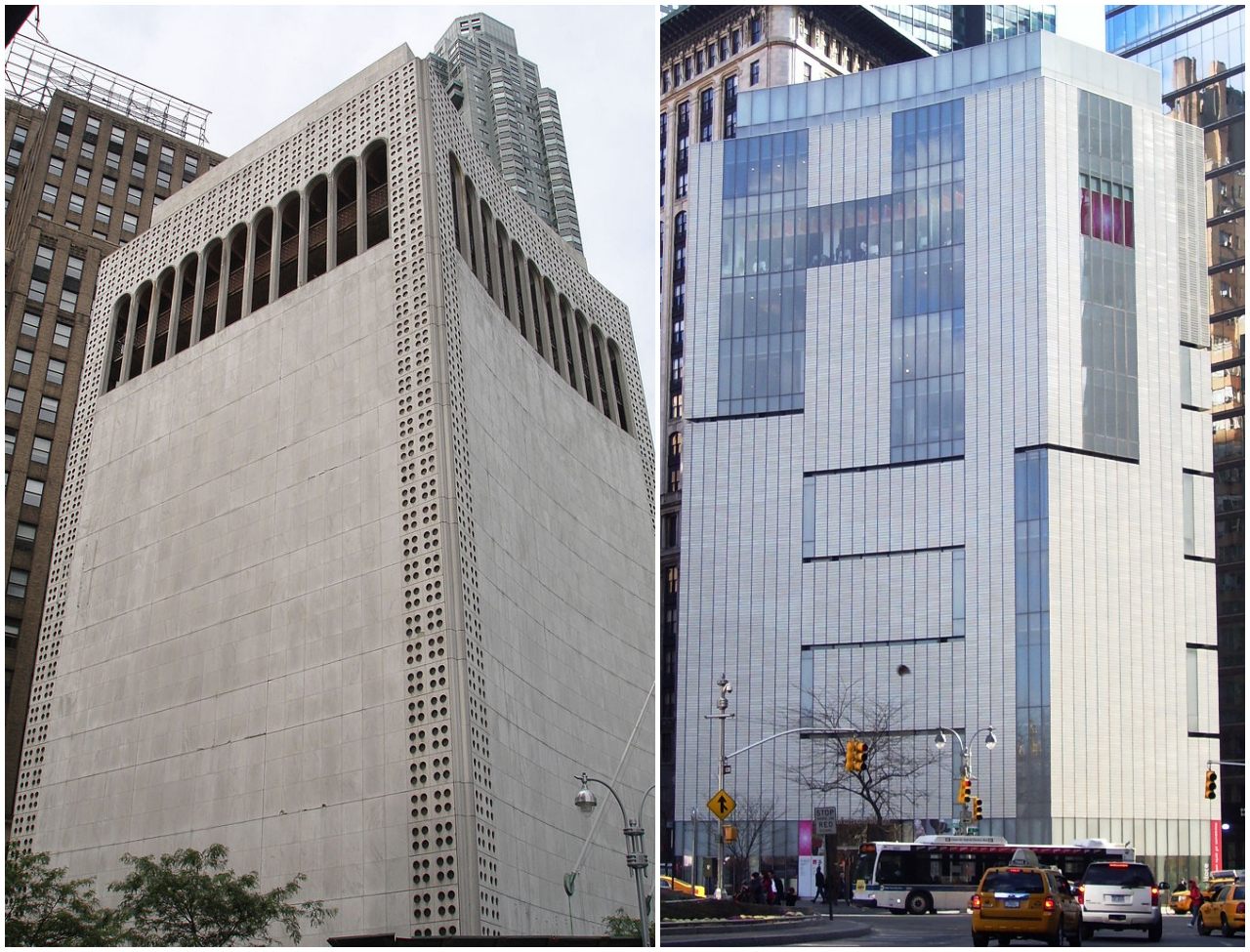 Before and after for the Gallery of Modern Art, now the Museum of Arts and Design (photographs by Renate O’Flaherty & Beyond My Ken)
Before and after for the Gallery of Modern Art, now the Museum of Arts and Design (photographs by Renate O’Flaherty & Beyond My Ken)
Sometimes a lost museum is hiding in plain sight. The Gallery of Modern Art, opened in 1964, once stood in a marble, modernist tower on Columbus Circle. Owned by George Huntington Hartford, it housed his collection, which was mostly concentrated on American and European paintings from the 20th century, its centerpiece being a painting by Salvador Dalí commissioned just for the museum called “The Discovery of America by Christopher Columbus.”
Hartford rather hated the direction of American culture, particularly Abstract Expressionism which he derided for instigating an ”ice age of art.” The museum designed by Edward Durell Stone was his own statement of what art should be. It closed after only five years.
When the Museum of Arts and Design moved in, the redevelopment did away with the stern, porthole-pocked stone exterior and replaced it with more playful, if less visually striking, glass and terra-cotta. Now only the ghost of the previous museum is remembered in the current institution’s silhouette.

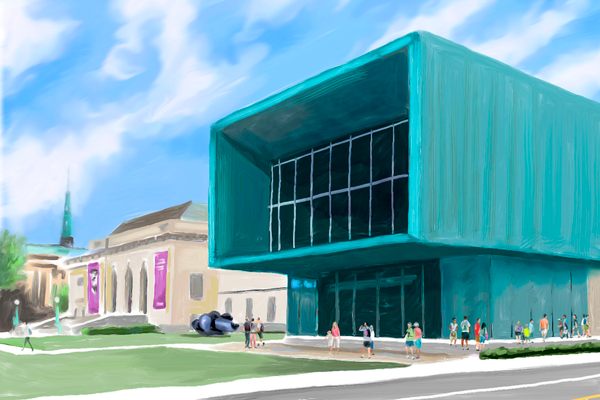































Follow us on Twitter to get the latest on the world's hidden wonders.
Like us on Facebook to get the latest on the world's hidden wonders.
Follow us on Twitter Like us on Facebook